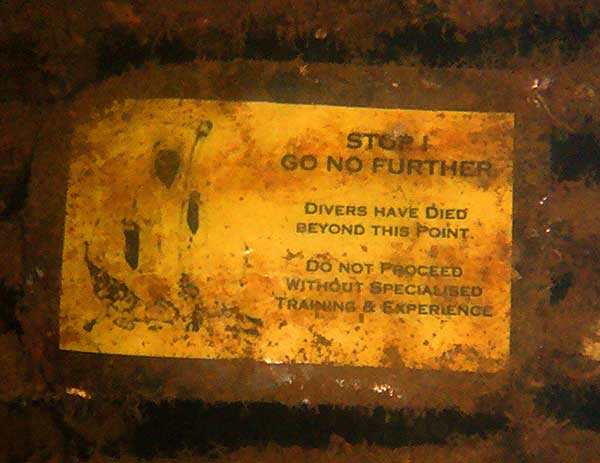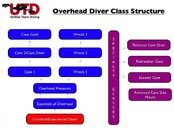CBasic training levels/implications for wreck diving:
Non-penetration diving (i.e. swimming over the wreck) - Basically, you can do this as an OW - AOW diver, although there are still some extra safety issues you might want to address by furthering your knowledge (self-study or PADI Wreck Diver course etc). Some 'wreck appreciation' adds enjoyment, stuff like; ship layout, historical research, mapping etc. Regular scuba equipment is sufficient for this.
Limited penetration diving, within the "light zone" - Requires, at least, a wreck diver course to expose you to effective drills and procedures for limited wreck penetration. Wreck Diver courses have a prerequisite of OW and AOW diver certification. The PADI Wreck Diver course doesn't give students much on this, but it's a start. Should include; use of torches, basic gas planning, navigation, guideline deployment, retrieval and following. Most importantly, it should provide you with basic risk awareness and assessment capabilities - just how silty is 'too silty', what may collapse and when, what exits are available and when would/could you use them.
Depending upon the actual penetrations conducted, the basic Wreck Diver courses may prove woefully inadequate. Further '
advanced-recreational' training can be sought that'd provide a more comprehensive skillset and knowledgebase specific to penetration dives. This could include; contingency drills for silt-outs, entanglements, precise dive planning and the use of redundant gas sources... along with a much higher competency in core dive skills, such as; buoyancy control, non-silting fin kicks, trim and situational awareness.
My workshop notes give an indication of what can be covered:
Advanced Wreck Workshop Notes
PADI, and many other agencies, define 'recreational wreck limits' as being: within the light zone (
directly illuminated by external natural light), no restrictions (
sufficient space for two divers to pass whilst sharing air side-by-side) and no more than 40m/130ft linear distance (
vertical and horizontal total) from the surface.
Even within those limits, a recreational diver can, if not properly trained, misappreciate the dangers of a wreck penetration and enter seemingly safe areas that are, in fact, very dangerous. The biggest danger being silt-out, loss of visibility and subsequent inability to find the exit. Other dangers include risk of entanglement (
your kit getting caught on projecting objects or getting tangled in wires or lines - including your own guideline).
Typically, you might consider graduating onto a BP&W BCD system for this level of diving, along with a 'long-hose'...and also decent fins that emphasis fine-tuned control (Scubapro Jets/OMS Slipstreams). Search this board for discussions about BP&W systems, DIR and Hogarthian diving styles. If wreck penetration is your overall goal - you may wish to get this kit in the first instance, to save needless expenditure and replacement.
Here's an 'advanced recreational wreck workshop' I ran...
[vimeo]36013044[/vimeo]
Full penetration diving, beyond the "light zone" - This is wreck diving with no limitations on penetration and is reserved for divers at, or beyond, technical diving level. Training is on a par with cave courses, including use of double tanks, options for decompression and a myriad of critical emergency procedures (lost line, lost buddy, cut line, entanglement etc), along with specific skills relating to the use of equipment in confined spaces and at unusual angles (inverted etc).
You're looking at an absolute minimum of 100 dives experience to qualify as a technical diver, plus prerequisite qualifications as Rescue Diver, Deep Diver and Nitrox Diver, along with a mandatory minimum of deep and nitrox logged dives. Core scuba skills have to be exemplary. Mindset is important - precision, perfectionism and conservatism count for a lot. Tech courses are typically in the $1000 range, plus another $2-4000 for kit. Technical Wreck courses are then in the $500-1000 range.
Technical Penetration - warning sign:





